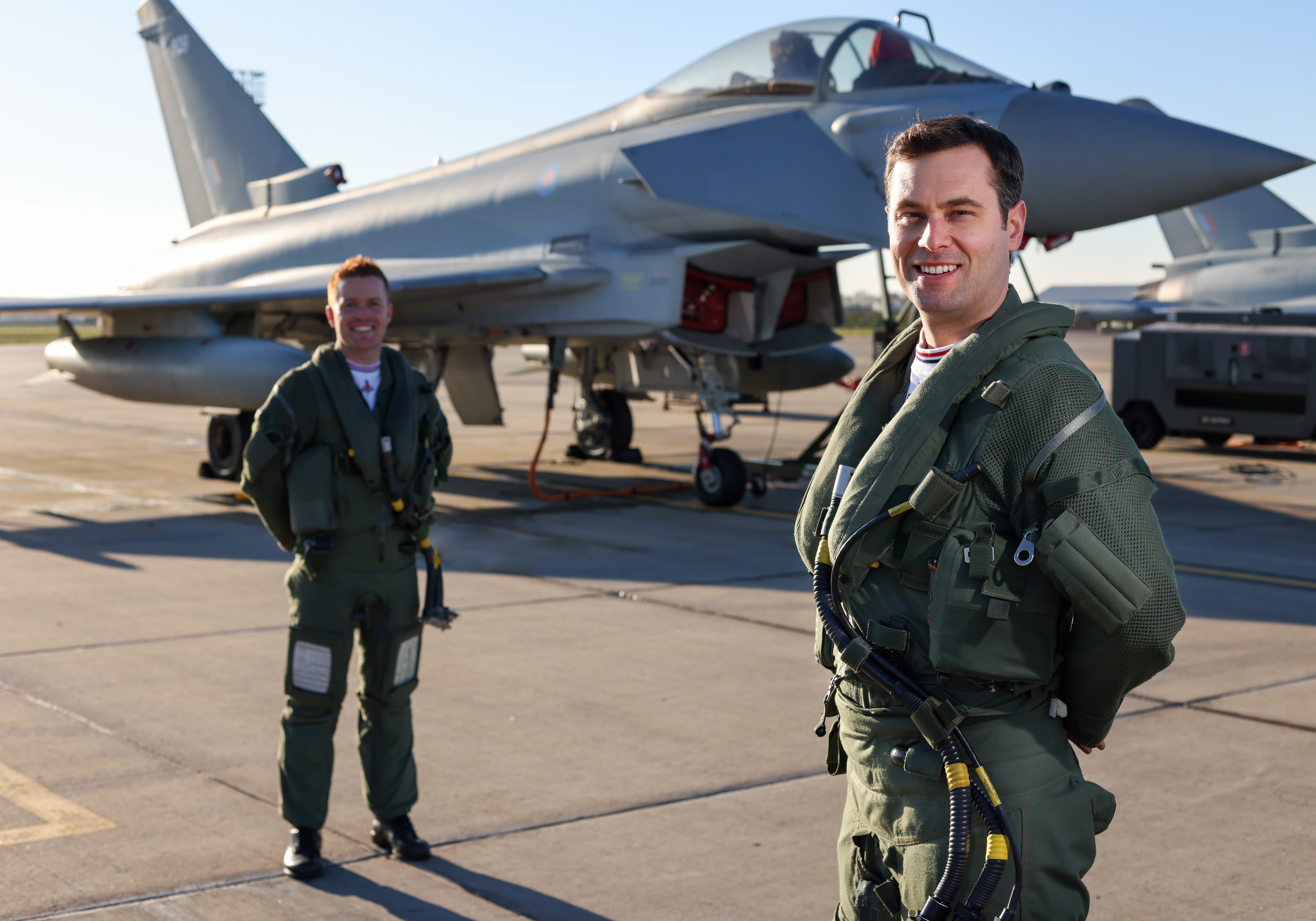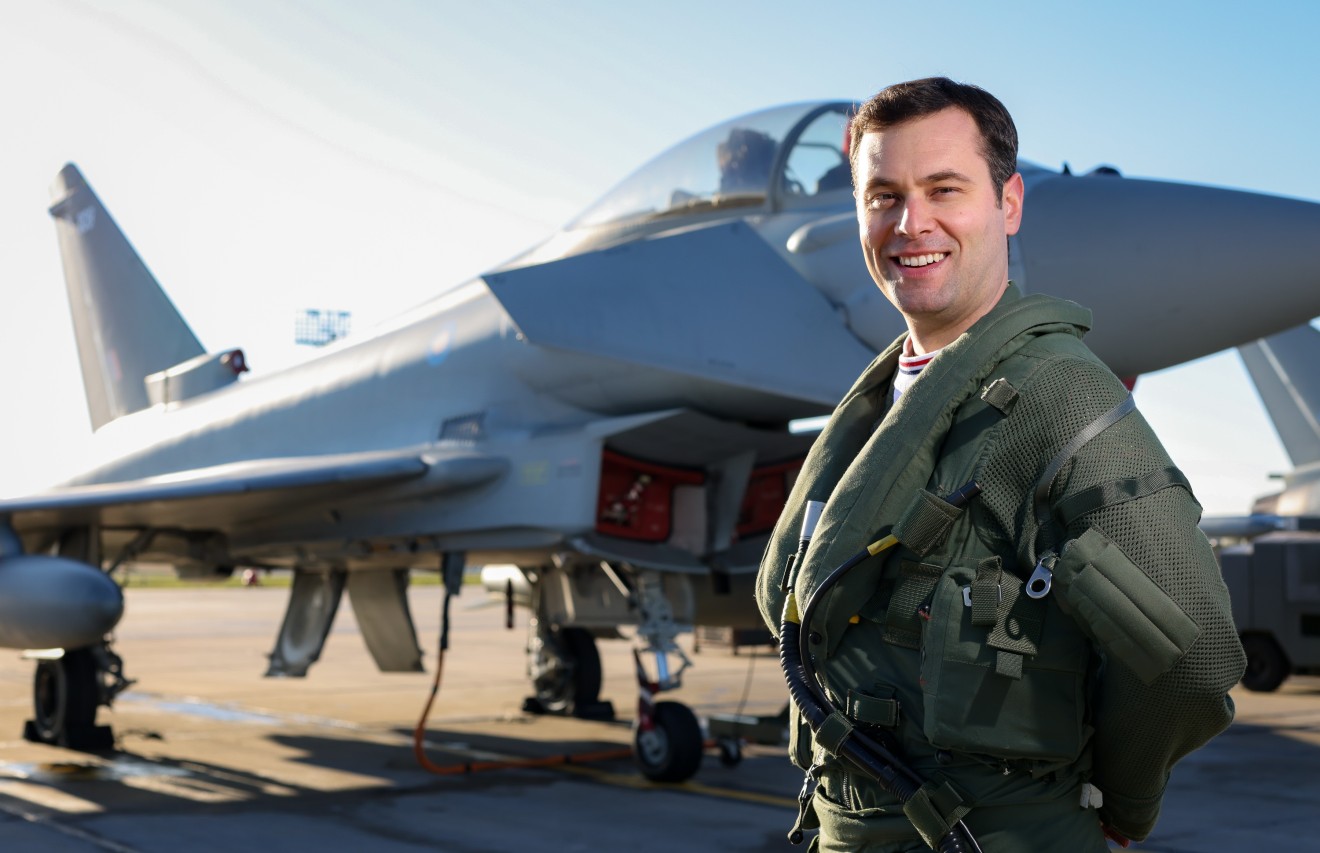Now Brighty has been selected as the RAF’s Typhoon display pilot for the 2023 season. Here he talks about the demands of the high-profile role, how he is looking forward to thrilling air show crowds and the many hours of work that is going into designing his routine.
What inspired you to become a pilot?
It was largely down to the fact my dad was in the RAF. I grew up around aircraft and spent a lot of time at different RAF bases around the country.
My interest in being a pilot was fostered even more by grandparents and uncles taking me to air shows and to watch planes at Gatwick Airport.
I first got my hands on controls when I was 13, when I had the chance to fly a motor glider with the air cadets. After that I was hooked. Then it was a case of honing the skills needed to fly and I was determined to join the RAF and pursue a military career.
Tell us something about your career to date?
I joined the RAF in September, 2007, and underwent standard flight training. Then I went to RAF Lossiemouth on the Tornado GR4s. By mid-2013 I was combat ready. Since then, I’ve served on squadrons involved in Operation Herrick and Operation Shader, as well as in the Falklands and on deployment to Estonia.
I was lucky enough to move across to the Typhoon in 2017. I joined 29 Squadron at RAF Coningsby in spring 2020. To date I’ve got 1,000 flying hours on Tornados and just shy of 700 on the Typhoon.
What was it like the first time you took to the air in a Typhoon?
It was awesome from the get-go. The amount of thrust and acceleration down the runway and once in the air, the manoeuvrability and the power.
No matter how many times you fly the Typhoon you never get bored of its characteristics. Sometimes you have to pinch yourself that you are lucky enough to get to fly this aircraft. It’s pretty fantastic!

What attributes do you need to become a display pilot?
You need to have a real determination and a passion for display flying. You’ve also got to be trustworthy in terms of operating with relatively minimal supervision throughout the display season.
You also need to have demonstrated a level of flying ability to operate the aircraft in this manner. And you have to approach the role with an open mind.
I feel very proud to have been chosen to do this. You feel the pressure a little bit, but I knew that coming into the job, it is something that you learn to deal with. Developing new skills is an aspect of the job that really excites me.
How are you developing your routine for the shows? How much work goes into it?
When it comes to the display you start with a blank sheet of paper. I began with the manoeuvres I’d seen over years of flying and personally enjoyed.
I then went back through YouTube and watched videos of displays from 2012 onwards, just picking out individual manoeuvres. It was then a case of thinking how I could mould them into my routine in the most eye-pleasing manner.
From that I put together some diagrams. Then it was a case of going to the flight simulator to test out the different moves and see how they flowed into each other, making adjustments, and then re-testing.
I probably got to an 80 per cent solution and then felt confident enough to show my supervisors, to get their take on it and their view on whether it would work or not.
How much testing is there to get the display into the air?
Once my supervisors give their seal of approval, the next step is formal simulator sorties to work up the display. There is still the opportunity to chop and change things.
We work to very strict rules and regulations. The work up is fixed. It’s a minimum of six simulator sorties. There’s also a minimum of two sequencies at 5,000ft before I’m allowed to go down to 1,500ft.
At that point, I have to have approval from the station commander. Then it is a minimum of 10 sorties at 1,500ft before I’m allowed to go down again to a height of 500ft. That, then, requires another simulator sortie at the new height before I can come down to the minimum, which is no less than 100ft.
All of the sorties, both in the air and in the simulator, are assessed by one of the supervisors. From the tower they will go through my tapes to see how I handle the aircraft and to make sure it is in accordance with the rules.
What is it about the Typhoon that makes it the star of the show?
People just love its manoeuvrability and its agility. They love the acceleration and speed of the Typhoon as well as the thunderous noise it makes. There’s also the visual impact of the afterburners. It is a big fans’ favourite.
Can you tell us anything about the display you are putting together?
I’m looking to try and keep things nice and tight, right in the front of the crowd and produce a combination of high speed and noise, with the visual impact that comes with the use of reheat.
Also, I’m looking to bring back a couple of manoeuvres that haven’t been seen for a few years. That includes the slow roll and holding the aircraft at a 90-degree angle.
Putting on displays is challenging. You have to be able to adapt the routine for different venues and be able to copy with varying or deteriorating weather conditions. It is both physically and mentally demanding. The work we are doing means we will be best prepared.
Apart from entertaining the crowds what role does the display team fulfil?
The primary role is to promote the ‘best of British’ through the fact we are exhibiting high levels of professionalism and expertise. We’re also championing the aircraft, the RAF and Typhoon Force.
I see myself slotting into an already established and experienced team. I really do count myself lucky I’ve been chosen.
The team has massive experience, with some members having been involved for almost a decade. It is a well-oiled machine and it is great to be part of such a professional unit, it fills you with confidence.
What are you looking forward to in your year in the job?
Obviously the big-high profile shows here and overseas, including the Royal International Air Tattoo that I enjoyed so much when I was growing up. But I’m also looking forward to some of the smaller, more intimate shows.
The main satisfaction for me will be putting a smile on people’s faces and bringing that sense of enjoyment and pleasure and excitement from watching a display that I got as a youngster. If I can do that, I’ll count it as a successful year.
